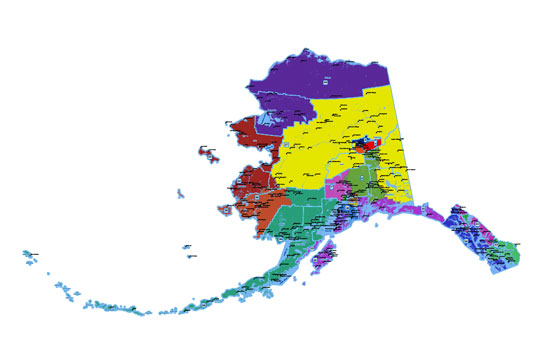The Alaska Redistricting Board released the plan Tuesday. And today (Wednesday), it considered a consultant’s report saying it would significantly reduce Alaska Native influence in one Interior House district and one western Senate district.
The plan responds to a recent state Supreme Court ruling saying the board put too much emphasis on protecting Native voting rights. The court said the board should have paid more attention to state constitutional requirements, which call for compact districts made up of similar communities.
The new plan changes election district boundaries for parts of the Aleutians and the Interior, as well as areas around Nome and Bethel. (See the statewide map of the new district boundaries.)
Redistricting Board Executive Director Taylor Bickford says the controversy does not include Panhandle communities. (See the Southeast map.)
“There was an influence district that was built in Southeast. But the board never claimed and the court never found that the board’s drawing of an influence district in Southeast led to violations of the Alaska Constitution,” Bickford says.
Petersburg officials hoped for new boundaries closer to its current district, which includes Wrangell and Sitka. Those districts were reworked because of population shifts from Southeast and to Southcentral Alaska.
The new plan combines Petersburg, downtown Juneau, Douglas Island and Skagway. That angers Petersburg Mayor Al Dwyer.
“We don’t think that Juneau is similar in any way to Petersburg or a fishing community. It has a processor there, but it’s not considered a fishing community. It’s a tourist community and a government (community),” Dwyer says.
“I completely understand why people would be unhappy. And I think there are a lot of unhappy people around the state,” says Juneau Democratic Representative Beth Kerttula, who serves in the House district slated to include Petersburg.
“All I can say is wherever the district I’m in is I’d be honored to represent it and work hard to do a good job,” she says.
Petersburg sued to change last year’s reapportionment plan. Mayor Dwyer says the Supreme Court ruling provides another opportunity to challenge the redistricting board.
“We kind of knew that they would propose that again. But we’re against it and we’re going to oppose it,” Dwyer says.
He says Petersburg could return to court, depending on the cost.
Redistricting shrinks the region’s legislative delegation from eight to six. That means four lawmakers – two in the House and two in the Senate – will likely run against each other.
That puts one Southeast Native lawmaker – Angoon Democrat Albert Kookesh – at risk.
Kerttula worries the court-ordered change in the redistricting board’s focus – from voting rights to geography – could further isolate Alaska Natives.
“Whenever you start to redraw the lines you’ve got to have your eye on the fact that under the federal law we can’t dilute Native power,” Kerttula says.
The board’s voting-rights consultant identified two of the districts redrawn after the court ruling as areas of concern. (Read the voting-rights expert’s memo on the new district boundaries.)
One is a House district made up Interior villages. The other is a Senate district running from Yakutat to Kodiak and from Lime Village to Dillingham and out the Aleutians.
The redistricting board is scheduled to meet through Saturday. Executive Director Bickford says it should finish its work by then.
“We’re really just playing by ear at this point. We’re trying to do our due diligence, build the best plan we can and do it in a timely fashion,” Bickford says.
In Southeast, other district pairings put Sitka in a district with small cities and villages from Haines to Port Alexander. Ketchikan, Wrangell and northern Prince of Wales Island are in one district. And Juneau’s Mendenhall Valley and Auke Bay area remain on their own.
The latest reapportionment plan makes no changes to Southeast Alaska election district boundaries.
- See a larger version of the new statewide map of the new district boundaries. (Small version below.)
- See a larger version of the Southeast map.
- Read the voting-rights expert’s memo on the new district boundaries.
Ed Schoenfeld is Regional News Director for CoastAlaska, a consortium of public radio stations in Ketchikan, Juneau, Sitka, Petersburg and Wrangell.
He primarily covers Southeast Alaska regional topics, including the state ferry system, transboundary mining, the Tongass National Forest and Native corporations and issues.
He has also worked as a manager, editor and reporter for the Juneau Empire newspaper and Juneau public radio station KTOO. He’s also reported for commercial station KINY in Juneau and public stations KPFA in Berkley, WYSO in Yellow Springs, Ohio, and WUHY in Philadelphia. He’s lived in Alaska since 1979 and is a contributor to Alaska Public Radio Network newscasts, the Northwest (Public Radio) News Network and National Native News. He is a board member of the Alaska Press Club. Originally from Cleveland, Ohio, he lives in Douglas.





